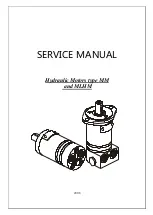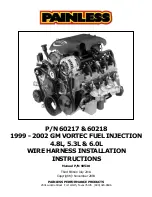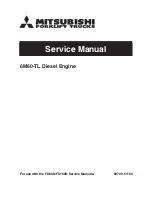
Starting the Engine
(Assuming the engine is mounted in
an aircraft)
Saito’s FG-36 carburetor comes
adjusted to a basic setting. This
setting should be maintained during
the initial break-in runs. The standard
carburetor settings are as follows:
The high-speed needle valve is set to
about 2 1/3 turns from the fully closed
position. The low speed or idle needle
valve is set to about 4 turns out from
the fully closed position. Please refer
to the diagram below.
Before you first start the engine, make
sure that the spark plug is screwed in
and tightened, and that the plug socket
cap is fitted in place and fastened
down properly. Fix the ignition sensor
in the proper position at the bottom
of the engine crankcase. The throttle
servo should be mounted at a distance
of 8 to 12 inches from the engine.
The spark plug cable must not touch
any part of the model structure as
vibration may damage the shielded
cable. If this is not practical, it will
be necessary to provide an insulation
material for the cable. The ignition
unit itself should be wrapped in foam
rubber to prevent engine vibration
from damaging the electronic
components. All components must be
protected from contact with engine
fuel. Be sure to use an on/off (Safety
or “kill”) switch to allow the ignition
to be turned off and on.
IMPORTANT:
Never turn the engine
over with the ignition turned on unless
the spark plug is inserted in the plug
socket. This could lead to ignition
damage.
Note:
The Saito FG-36 is a 4-stroke
gasoline engine with a pumped
carburetor. You do not have to choke
the engine as you normally would a
2-stroke engine.
When you are ready to start the engine
switch the ignition on and set the
throttle to a slightly high idle speed.
We highly recommend the use of an
electric starter to start the FG-36.
Be sure to have a helper hold the
model securely.
Figure 5
S T A R T I N g T h E E N g I N E
7
6
B E F O R E S T A R T I N g T h E E N g I N E
CAUTION:
If fuel remains in the
carburetor after flight, the components
made from rubber, such as the
diaphragm, will deteriorate over
time. After a flying session, it is best
to remove any fuel remaining in the
carburetor.
Do not needlessly disassemble the
carburetor. If you experience problems
with the carburetor, return it to the
Saito Horizon Service Center.
Preparation Before
Starting the Engine
(prior to break in)
• Mount the engine on a
strong, parallelized test bench or
on the aircraft. (In either case,
the engine should be secured so it is
immobile.)
• Check to make sure the throttle
barrel will open and close
completely.
• Check the wring of the ignition
system to make sure it is connected
correctly and securely.
• Use a 350cc to 450cc fuel tank on
the test bench or in the aircraft.
• Make sure the fuel line is connected
securely to the carburetor.
• For break in, use a fuel/oil mix ratio
of 20:1.
• Mount an 18x8 or 19x8 carbon
fiber propeller such as a Bolly
or Mejzlik. Be sure it has been
balanced.
• It is suggested you employ a
spinner when using an electric
starter. (Remember to check the
tightness after every flight.)
• Use a tachometer to prevent over-
revving of the engine.
• Be sure to connect a gasoline-proof
line to the breather nipple to vent oil
from the airframe.
• Check the battery of the electric
starter to make sure it is fully
charged. Be sure to use a safety
on/off switch from the battery to the
ignition.
WARNING:
Do not let people stand
in front of the engine while attempting
to start it. Also, make sure the engine
test bench or aircraft is completely
secure from movement.






























